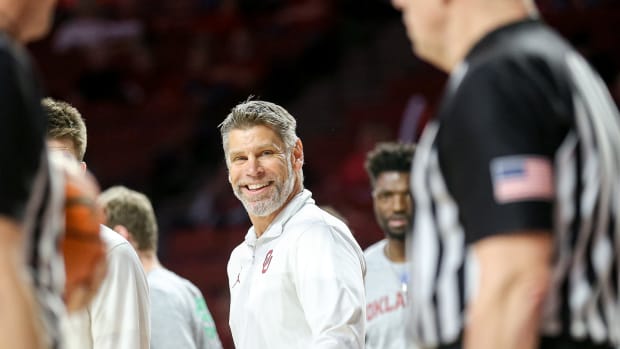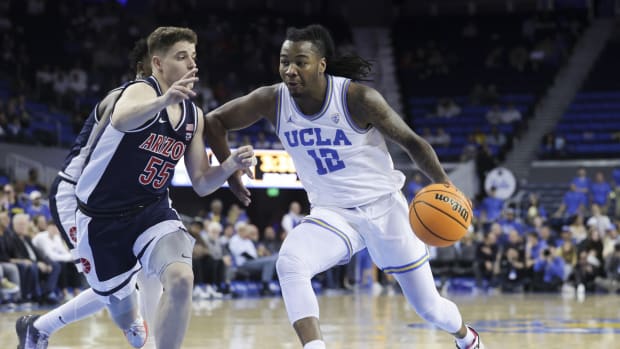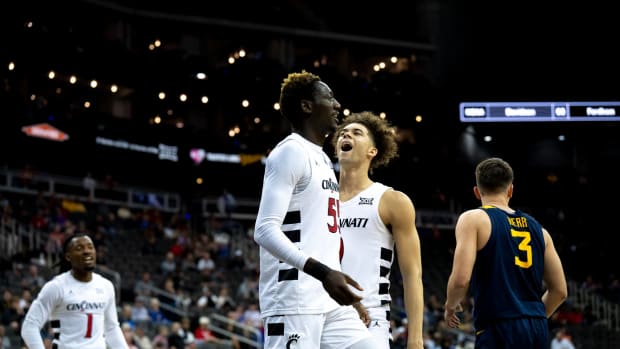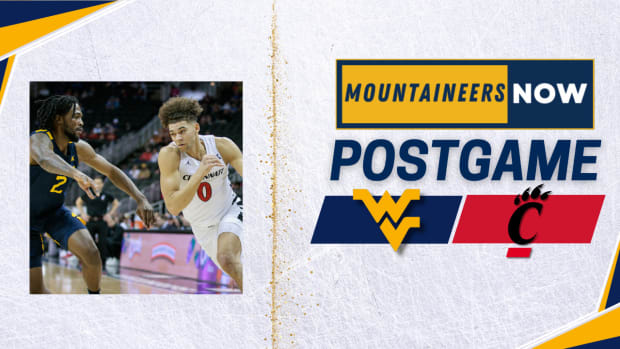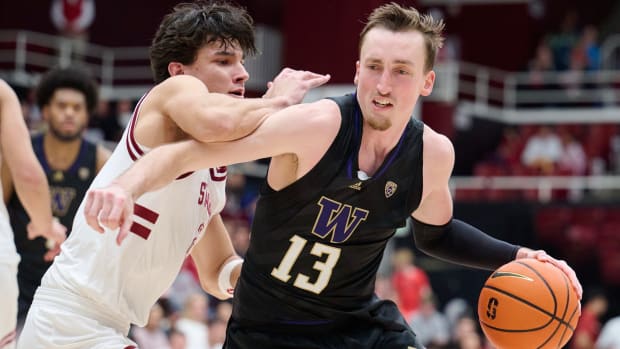Power Rankings: How the projected No. 1 seeds score
March is when rankings cease to really matter, or matter even less than they ever did. It’s all about the brackets now, so the Power Rankings is changing its format. There are still 32 teams listed in order, per tradition, but the entire focus is on the four projected No. 1 seeds—and on providing extended Scouting Reports of their offenses in advance of the NCAA tournament. This is what you need to know about how the projected No. 1s score, and where they’re lacking:
1. Kansas (26–4) LW: 1
Offensive Scouting Report: It all starts with senior power forward Perry Ellis, who’s been around forever but hasn’t ever been this good. Kansas used to feed Ellis primarily on the blocks, but he’s added an occasional three to his arsenal (he’s making 47.2% of them this season), and it’s become more advantageous for KU to let him start with the ball on the perimeter and then go to work.
The Jayhawks will frequently open halfcourt possessions against man-to-man D with a high ballscreen set by Ellis for point guards Frank Mason or Devonte’ Graham. Ellis will pop to the three-point line after the guard drives off the screen, receive the ball, and size up his defender. In KU’s Feb. 29 win over Texas, the Longhorns switched some of these screens, leaving 5'11" Javan Felix on the 6'8" Ellis, and Ellis’s obvious best option was to attack off the bounce. For a power forward, his dribble-drive pacing and control is impressive, and helps him maintain a low turnover rate:
When Kansas uses junior center Landen Lucas as the initial screener, he’ll roll to the rim and Ellis will replace him at the top of the key, and receive a kick-out from a guard who has collapsed the defense. Ellis can then shoot the three, or shot-fake and attack the opposing big man’s closeout off the bounce, as he does here against Texas’s Connor Lammert:
Kansas is taking more threes than it has in years past—35.8% of its Big 12 shot attempts have been treys, which isn’t a high ratio when compared to three-point-oriented teams such as Oklahoma or Villanova, but it’s high for a Bill Self team. The two guys most impacted by this are guards Wayne Selden and Graham, who are taking more threes than twos for the first time in their careers. Graham has been the team’s hottest long-range shooter in Big 12 play, and he’s especially effective at pulling up for threes in transition. He’s a big reason why they’re fourth in the nation in three-point percentage, at 42.6%.
Kansas also has a unique weapon it can bring off the bench—a 6'7" wing, Brannen Greene, who makes 53.6% of his treys. Greene’s playing time is fairly limited because he’s a defensive liability, but if he subs in for an out-of-bounds play or the final possession of a half, it’s a safe bet that the Jayhawks will try to run him off multiple screens—either staggered or the “elevator doors” alignment that’s all the rage these days—to set up a three. Here’s an example from their win over West Virginia on Feb. 9:
I would not consider zoning this team—Ellis is the perfect power forward for operating in the middle of a 2-3, and the Jayhawks as a whole average 1.45 PPP on unguarded catch-and-shoot situations. If your zone is slow to recover, it’s over.
Shortcomings: KU isn’t a killer offensive rebounding team in its four-out, one-in alignment, which often keeps Ellis out of prime putback positions. ... Selden’s turnover rate (16.8% of his possessions in Big 12 games) is a bit high for a sharpshooter who plays off the ball, and his streakiness as a shooter is still a concern. ... The turnover rates for the Jayhawks’ backup bigs—senior Jamari Traylor, and freshmen Cheick Diallo and Carlton Bragg—are alarmingly high and drag down the offense when Lucas or Ellis is off the court.
2. Michigan State (25–5) LW: 2
Offensive Scouting Report: This is the nation’s most efficient offense, and its formula for success is combining three elite long-range shooters (Denzel Valentine, Bryn Forbes and Eron Harris) with two high-volume offensive rebounders (Matt Costello and Deyonta Davis). Forbes and Valentine are Nos. 1-2 in the Big Ten in three-point percentage and Costello leads the conference in offensive-board percentage.
The Spartans should be considered the country’s best jump-shooting team not just because they’re No. 1 in three-point percentage (43.7), but also because they have so little drop-off between their catch-and-shoot efficiency (which ranks No. 4 among major-conference teams) and off-the-dribble efficiency (No. 1). Via Synergy Sports Technology’s logs through Tuesday’s games, here are Michigan State’s catch-and-shoot vs. dribble-and-shoot efficiencies in halfcourt situations, versus three other of the nation’s best catch-and-shoot teams, Oklahoma, Duke and Indiana:
The Spartans’ off-the-dribble numbers are largely fueled by Valentine (he scores 1.30 PPP pulling up for jumpers off the pick-and-roll) and Forbes (1.39 PPP on all dribble Js, the best of any major-conference player). That, combined with Forbes’s insane off-the-catch efficiency (1.43 PPP), and the fact that he runs off so many screens in the course of almost every possession, makes him a huge pain to defend. State’s big men, particularly Costello, are strong off-ball screeners, and they like to run elevator doors and pindowns for Forbes—this game-opening possession against Ohio State being a good example:
There can be as many as four stages to a typical Michigan State possession: an initial attempt by Valentine to push the ball in transition, often off of his own defensive rebound; a look for quick points off of secondary-break options such as pindowns for Forbes; a called set; and then Valentine using ballscreens in end-of-shot-clock situations. The fact that the 2015–16 Spartans are adept in all four of these stages bodes well for them in the NCAAs, as they should be able to adapt to any style of opposing D. And although North Carolina is most famous for its secondary-break scoring, Michigan State is better at it than the Tar Heels are this season; defenses will often fall into a post-primary-break lull and get burned by actions like this one:
Shortcomings: Because of their comfort with pulling up for jumpers off the dribble, the Spartans draw fewer fouls than most teams, ranking 334th nationally in percentage of points from the free-throw line. On their coldest of shooting nights, that becomes an issue. ... If they do work sophomore point guard Lourawls Nairn back into the rotation in a significant way following his injury hiatus, they’ll be sacrificing offense for defense, as his inability to shoot the three impacts their spacing.
3. Virginia (23–6) LW: 5
Offensive Scouting Report: This is Tony Bennett’s best offense ever at Virginia, and senior two-guard Malcolm Brogdon is having his best offensive season. He’s handling a heavy workload (taking 31.0% of the Cavaliers’ shots) with high efficiency (a 121.4 ORating), and outside of Valentine-Forbes at Michigan State, you won’t find a more efficient backcourt than Brogdon and junior point guard London Perrantes at Virginia.
The Cavaliers do everything in the halfcourt, rarely going into transition on anything other than a live-ball turnover. They run a motion offense that, in contrast to many other elite teams, makes very little use of ballscreens; pick-and-rolls constitute just 14.3% of Virginia’s offense, according to Synergy. Off-ball screening and ball movement are what drive Virginia’s success. Each of its two big men is assigned a side of the court in which to act as a roving screener, and Brogdon is excellent at using these screens by reading and reacting to how defenses choose to guard them. The following video edit from the Cavaliers’ Feb. 27 win over North Carolina is the Most Virginia Reel Ever—it’s just variations of Brogdon, away from the ball, using a backscreen, reversing course, and then using a downscreen. In the first clip Brogdon fades to the three-point line, in the second he curls into a runner, and in the third he curls into a jumper:
Senior forward Anthony Gill is a solid post-up player, but his best skill is as a reactor to what happens after these screening actions. There is no big man in the country with a better sense of spacing off of a guard’s drives. Gill knows exactly when to expand to the baseline to force his defender to commit to sticking with him or stepping up to cut off a driver, and his timing on basket cuts is impeccable. He may not shoot jump shots or stretch the floor, but his offensive IQ and finishing ability around the rim are second-to-none. This clip, from Virginia’s Feb. 13 loss at Duke, shows Gill in prime reaction/expansion/flashing form:
Shortcomings: The Cavaliers’ offensive-rebounding numbers are down from last season, in part due to the loss of Darion Atkins, but also because they’ve opted to play smaller lineups with Isaiah Wilkins at the four. ... They’re a good free-throw shooting team that can cling to leads if the ball stays with Brogdon and Perrantes, but overall they don’t draw many trips to the line. ... For a team with a trio of strong long-range shooters in the aforementioned guards and Marial Shayok, they could leverage the three more than they do. Just 27.9% of their attempts come from deep.
4. Villanova (26–4) LW: 6
Offensive Scouting Report: When ‘Nova coach Jay Wright told Sports Illustratedthis week, that “I think [this is] a team that could have perfect balance, and that’s what we’re striving for,” he was talking about the balance between threes and twos—because his team is still three-point oriented, taking 41.1% of its shots from deep in Big East play. Where the the Wildcats are already balanced is in their distribution of offensive possessions, as the usage rates of their top six rotation guys are all between 20.1% and 23.3%, making them the most evenly spread of the title contenders.
Although he doesn’t get enough national recognition for it, senior center Daniel Ochefu might be the most valuable part of Villanova’s offense. Since Big East play began on Dec. 31, the Wildcats’ on/off efficiency splits with Ochefu—they score 1.16 PPP with him, 1.07 PPP without him, according to hooplens.com—indicate that they reach their peak level only with him as the “one” in their four-out, one-in motion. Ochefu is a talented post scorer, especially from the left block (1.21 PPP), where he can drop in righty hooks, but his biggest contributions come as a ball-mover.
Ochefu might be the best passing center in the nation, and Villanova likes to run motion where he sets a ballscreen, rolls to a spot just off the blocks, then gets a post entry from the wing—but he posts to a spot a few feet off of the blocks to leave the lane open for cutters. He’ll survey the court over the shoulder that’s farthest from the baseline, and throw passes to guards making a break for the rim. Two examples of this from the Wildcats’ Feb. 27 win at Marquette:
Villanova’s success doesn’t have much to do with threes—it has to do with getting great looks around the rim. Shotanaltyics.com ranks Villanova as the No. 2 major-conference team in shooting percentage within five feet of the basket, at 69.1%, behind only North Carolina. Many of these are layups and dunks off of cuts, but the Wildcats also excel at making smart drives to the rim, attacking favorable defensive matchups or off-balance close-outs rather than ill-advised isolations.
Junior wing Josh Hart’s Big East Player of the Year campaign is built his high-efficiency drive-and-finish game. Much of the ballscreening ‘Nova does is not in the interest of looking for a roll or pop man, but in drawing help, then kicking the ball to a wing to set up a drive against a recovering defender—or setting up a series of quick drive-and-kicks that eventually stretch a defense to its breaking point. Here’s an example of the Ochefu-post play in which he hits Hart on the opposite wing, and Hart makes easy work of his defender off the bounce:
Shortcomings: They play so small—with 6'6" Kris Jenkins and 6'7" Mikal Bridges—that Ochefu and backup center Daryl Reynolds don’t have much offensive rebounding support. ... Auxiliary freshman point guard Jalen Brunson has a turnover rate in Big East play of 26.2%, which makes him one of their least-efficient regulars. ... They love in-rhythm threes but just don’t hit them with anywhere near the accuracy of a Michigan State or Kansas, ranking 227th in three-point percentage.
The Next 28
5. Oklahoma
6. North Carolina
7. Miami
8. Xavier
9. Oregon
10. Indiana
11. West Virginia
12. Utah
13. Duke
14. Kentucky
15. Louisville
16. Purdue
17. Baylor
18. Iowa State
19. Arizona
20. Maryland
21. Texas A&M
22. Cal
23. Iowa
24. Texas
25. Wisconsin
26. Wichita State
27. Vanderbilt
28. SMU
29. Saint Mary's
30. Notre Dame
31. VCU
32. Saint Joseph's

